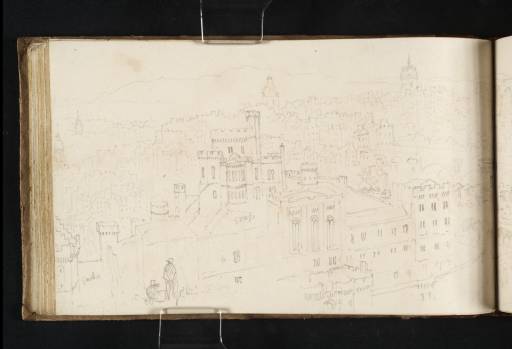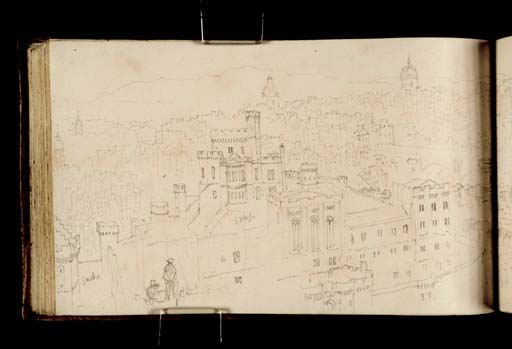Joseph Mallord William Turner Edinburgh from Calton Hill 1818
Image 1 of 2
Joseph Mallord William Turner,
Edinburgh from Calton Hill
1818
Joseph Mallord William Turner 1775–1851
Folio 41 Verso:
Edinburgh from Calton Hill 1818
D13651
Turner Bequest CLXVII 39a
Turner Bequest CLXVII 39a
Pencil on white wove paper, 112 x 186 mm
Inscribed in pencil by Turner ‘Grass’ centre; ?‘Gardens’ bottom left; ‘6’ lower centre
Inscribed in pencil by Turner ‘Grass’ centre; ?‘Gardens’ bottom left; ‘6’ lower centre
Accepted by the nation as part of the Turner Bequest 1856
References
1909
A.J. Finberg, A Complete Inventory of the Drawings of the Turner Bequest, London 1909, vol.I, p.486, CLXVII 39a, as ‘Edinburgh, from the Calton Hill. See Engraving in part IV. of Scott’s “Antiquities.”’.
1910
Alexander J. Finberg, Turner’s Sketches and Drawings, London 1910, pp.107–8, plate 60 opposite p.106.
1974
Gerald Wilkinson, The Sketches of Turner, R.A. 1802–20: Genius of the Romantic, London 1974, p.178 reproduced.
1974
Martin Butlin, Andrew Wilton and John Gage, Turner 1775–1851, exhibition catalogue, Royal Academy, London 1974, cat.204.
1979
Andrew Wilton, J.M.W. Turner: His Life and Work, Fribourg 1979, p.426 under cat.1062.
1983
Timothy Clifford, J.M.W. Turner: Aquarelles de la City Art Gallery, Manchester, exhibition catalogue, Musée des Beaux-Arts, Bordeaux 1983, p.38 under cat.10a.
1985
Timothy Clifford and Shuji Yashiro, Turner at Manchester, exhibition catalogue, Odakyu Grand Gallery, Tokyo 1985, p.[47] cat.10.
1990
Diane Perkins, The Third Decade: Turner Watercolours 1810–1820, exhibition catalogue, Clore Gallery, Tate Gallery, London 1990, p.45 cat.54 reproduced.
1997
Charles Nugent and Melva Croal, Turner Watercolors from Manchester, exhibition catalogue, Memphis Brooks Museum of Art, Memphis 1997, p.6 under cat.33.
1999
Katrina Thomson, Turner and Sir Walter Scott: The Provincial Antiquities and Picturesque Scenery of Scotland, exhibition catalogue, National Gallery of Scotland, Edinburgh 1999, pp.26–7, 31, 85, reproduced p.27 fig.8.
2000
Turner Society News, no.85, August 2000, p.12.
Turner made just two sketches in preparation for his watercolour, Edinburgh from Calton Hill, circa 1819 (National Gallery of Scotland),1 commissioned for the Provincial Antiquities of Scotland (see Scotland 1818 Tour Introduction). The first is a quick but precise single page sketch in the Bass Rock and Edinburgh sketchbook (Tate D13430; Turner Bequest CLXV 59a), testing the view and composition of the subject. The second is a careful and detailed panorama of the view across the present page, and continuing on folios 42 and 43 (D13652, D13654; CLXVII 40, 41). Turner seems to have had no doubts about his subject and composition, and presumably made the single page sketch first as a practice before deciding to alter his vantage point slightly (moving to the north) and beginning his most intricate and detailed drawing of the 1818 Scottish tour.
There were, however, precedents to follow; the view was known as one of Edinburgh’s most impressive and was described by Walter Scott as ‘one of the most magnificent scenes in this romantic city’.2 Turner had seen it in 1801, and in 1804 he exhibited a watercolour of Edinburgh from Calton Hill at the Royal Academy (Tate D03639; Turner Bequest LX H). The new view varies considerable however from that rather pastoral vision by concentrating on ‘the “daring spirit of modern improvement” represented by the development of Regent Bridge and Waterloo Place at the foot of Calton Hill’.3 It is nevertheless still remarkable how close his final design was to this plein air sketch, suggesting that Turner was able to envisage the final work as he stood sketching this view.
Turner stood at a high point on the west of Calton Hill, perhaps at the base or even the top of Nelson’s Monument, and looked south-west across the city towards the castle. Two figures stand just beneath him, one sitting, one standing, both admiring the view and recalling Turner’s own act of looking.4 In front of the figures, and dominating the bottom half of the present page, is the once mighty Calton Gaol, built in 1808 to replace the Canongate Tolbooth, but now largely demolished apart from the central turreted section of the Governors’ House to make way for St Andrew’s House (see Tate D13434; Turner Bequest CLXV 61a).
To the right at the very edge of the page is David Hume’s ‘Roman Tomb’. The tomb stands in Calton Burial Ground which is drawn at the left of folio 42 in front of Regent Bridge (see folio 36; D13643; CLXVII 34). Behind the tomb, continuing on folio 42, is the old North Bridge (see Tate D13567; Turner Bequest CLXVI 61) connecting Edinburgh’s Old Town, shown here on the present page, with the New Town, depicted on folios 42 and 43. In the centre at the top of the present page is the old spire of the Tron Kirk, with the spire of St Giles’s Cathedral to the right (see folio 64 verso; D13695; CLXVII 61a).
Folio 42 is dominated at the top left by Edinburgh Castle and the rest of the page shows mainly the New Town with the Church of St John the Evangelist (see Tate D13462; Turner Bequest CLXVI 7a), St Cuthbert’s and the Register House as the most distinctive landmarks, as well as the rooftops of houses in Waterloo Place at the bottom right.
The watercolour design follows this sketch closely in its composition and the details of its parts. However, Finberg notes that despite following
his sketch with great care [...], the whole material has been hammered this way and that by his powerful hand. We can see that the artist felt impatient with nature’s calm and unhurried chronicle of facts, and was determined at all costs to make a more immediate and concentrated attack on the spectators’ power of perception.5
Indeed in order to include most of a two and a quarter page drawing into the relatively square format of the watercolour, Turner needed to compress significantly the composition horizontally, bringing features such as the two church spires on the present page closer together, squeezing Calton Gaol and turning it anticlockwise on its axis, squashing the castle and Princes Street and foreshortening most other objects such as the houses of Waterloo Place, almost without missing out any features or sacrificing any details. However this manipulation was not just to fit in all of these details, it was also to tighten up the composition, bringing objects of interest into a neat, almost square, format and creating a series of interconnecting lines and planes that give the whole a strong and unified structure, while creating a slightly dizzying sense of movement around the picture that emphasises the high vantage point and the crowded and diverse character of the city. In Finberg’s words, ‘Instead of stretching out calmly and indifferently on both hands, as in the sketch, the city in the finished design seems to soar upwards from the depths beneath our feet’.6
The drawing style of the sketch is simple and straightforward, largely eschewing artistic techniques, such as shading and hatching, except by varying the weight of the line,7 with a stronger line for landmarks and a fainter line for the mass of buildings in the middle distance. Despite the number of lines on the page, Turner, as always in these sketchbooks, is economical whenever he can be. Calton Gaol is perhaps the most detailed thing in the picture; a result, no doubt, of Turner having not sketched it in detail elsewhere, as well as of its own complex and confusing architecture of various turrets, different shaped windows, rooflines and different architectural patterns and features. Turner has still, however, taken the opportunity to save time and prevent the confusion of too much detail by drawing just one window on the bottom left façade but reminding himself with an inscription that there are ‘6’. Two further features that are too difficult to draw and would only confuse the picture more than is necessary are noted rather than drawn: ‘garden’ and ‘grass’.
The streets and houses of the Old and New Town are drawn in surprising detail, with walls, windows, roofs and chimneys of dozens of houses individually depicted. Many of these are reproduced in the watercolour (though often moved and manipulated), creating an intricate mass of detail that adds to the charming jumble of the city. It is only when Turner depicts the rooftops of the furthest visible buildings that he employs a crenellated line as a shortcut. In contrast he leaves the castle as a mere outline with just a few details such as the position of the Half Moon Battery (see Tate D13445; Turner Bequest CLXV 67) specifically indicated. Turner made dozens of sketches of the castle from every direction so there was no need to add further detail. Perhaps he had already decided that the castle would be shrouded in the watercolour by a soft mist.
The drawing following this in the sketchbook is of Figures on Calton Hill (folios 42 verso–43; D13653–D13654; CLXVII 40a–41), and shows the artist recording more information about Calton Hill and collecting examples of staffage for his watercolour.
Thomas Ardill
March 2008
Walter Scott, The Provincial Antiquities and Picturesque Scenery of Scotland with Descriptive Illustrations by Sir Walter Scott, Bart., Volume II, London and Edinburgh 1826, p.[83].
How to cite
Thomas Ardill, ‘Edinburgh from Calton Hill 1818 by Joseph Mallord William Turner’, catalogue entry, March 2008, in David Blayney Brown (ed.), J.M.W. Turner: Sketchbooks, Drawings and Watercolours, Tate Research Publication, December 2012, https://www


